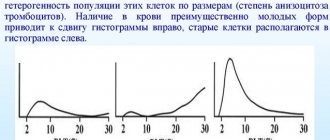A general detailed blood test is a fairly inexpensive method for diagnosing the whole organism, which at the same time has high accuracy of results. Such a study will help identify a malfunction in any organ of your body.
The information content of a general detailed blood test allows you to prescribe subsequent examination and treatment of the patient. Absolutely any person undergoes this analysis, and the first time he encounters this study is when he is a newborn.
Blood test online transcript for free
Laboratory analysis of blood composition (general clinical or blood biochemistry) are a very important “tool” for every doctor and occupy a special place among laboratory diagnostic methods. A blood test allows you to determine various hematopoietic disorders, identify various pathological changes in human tissues and organs, and also generally assess the condition of our body.
However, deciphering a blood test and interpreting its results requires special medical training and is extremely difficult to do on your own. However, in some cases, even before visiting a doctor, we want to understand whether everything is normal with our blood and what possible reasons could cause this or that deviation in its composition? In such a situation, our “Blood test online decoding” will help you instantly decipher the results of the study specifically based on the results of your laboratory analysis. With its help you can get general explanations about clinical blood tests.
A general blood test provides valuable information about the number, size and shape of the constituent elements of blood - red blood cells, hemoglobin, platelets, and leukocytes. For each analysis indicator there is a norm - a range of normal values for these indicators. Normal values are different for men, women and children. In addition, the norm also depends on the age of the patient. Therefore, when using our “Online Blood Test Transcription” , do not forget to indicate your age and gender.
In a healthy patient, the cellular composition of the blood is within normal limits. In the presence of a disease, the values of individual indicators go beyond the normal range, since a certain disease manifests itself in a change in the composition of our blood. Even just one change in the composition of our blood can indicate the presence of several diseases. Conversely, to confirm the diagnosis, it is necessary to analyze and compare the values of several indicators, taking into account the individual characteristics of the patient. Therefore, our service “Blood test online interpretation” provides only general information about normal values and possible causes of deviations, and cannot replace a visit to the doctor and, moreover, is not a sufficient basis for making a diagnosis.
| General blood analysis |
| Blood test biochemistry |
Blood chemistry
It is a laboratory test that allows you to diagnose the condition and performance of internal organs: liver, kidneys, pancreas, gall bladder, etc. The method also makes it possible to collect information about metabolism and identify the need for microelements.
Indications for prescription by a doctor
Our clinic’s specialists recommend undergoing blood biochemistry at least once a year, even for those people who have no health complaints. Thus, you can always detect problems in time and prevent the formation of chronic diseases. Biochemical analysis is prescribed by a doctor for infectious and somatic diseases.
Diagnosis of diseases based on deviations from the norm
The results of the study provided to the patient contain the established values of the studied indicators, as well as the acceptable norm (corridor of indicator values in a healthy person). When the set values leave this corridor, we can talk about the presence of problems with the patient’s health.
A biochemical blood test is the best way to timely diagnose a whole range of serious diseases. It is better to cope with the disease at an early stage, to prevent the disease from becoming chronic.
General blood test decoding: the meaning of individual indicators.
Blood test interpretation: Red blood cells
Erythrocytes are the red blood cells of our blood, formed in the bone marrow. It is the red blood cells that give our blood its red color. The main function of red blood cells is to carry oxygen. Normal red blood cell levels vary by age and gender. An increased level of red blood cells may indicate insufficient adrenal function, the presence of toxicosis, dehydration, chronic heart and lung diseases, erythremia, and some hormonal diseases. A low level of red blood cells is associated primarily with insufficient bone marrow function and is observed in cancer, vitamin B12 deficiency, anemia, bleeding, thalassemia, blood leukemia, etc.
Blood test interpretation: Hemoglobin
Hemoglobin is an iron-containing protein that is a component of red blood cells - erythrocytes. Hemoglobin has the ability to bind oxygen and transport it throughout the body through the bloodstream. Reduced hemoglobin levels are primarily due to a lack of iron in the body, as well as a deficiency of vitamin B12 or folic acid. It is also observed in hemolytic, aplastic and sickle cell anemia.
Blood test indicator - Hematocrit
Hematocrit shows how much of the blood volume is occupied by red blood cells - erythrocytes. Most often, hematocrit is measured as a percentage. A low level of this indicator may indicate blood loss, hyperhydration, excessive salt consumption, an unbalanced diet, etc. A high level is characteristic of erythremia, erythrocytosis, hypoxia, dehydration, kidney disease, and side effects of medications. The normal hematocrit level is different for men and women, and for women it is slightly lower than for men.
Blood test: Leukocytes
Leukocytes are blood cells primarily responsible for immunity and restoration of our body. An excessive level of leukocytes can signal inflammation of tissues or organs, the presence of infections in the body, hidden bleeding, abscesses, necrosis, intoxication, blood leukemia, etc. A low level may also indicate viral infections (at the stage when the virus has suppressed the normal functioning of the immune system ), rheumatic diseases, radiation sickness, side effects of drugs, etc.
Blood test - ESR indicator
ESR is the erythrocyte sedimentation rate measured in millimeters per hour. The normal value of this indicator depends on age and gender. The protein composition of the blood is the main factor influencing ESR. The more proteins in the blood, such as globulin and fibrinogen, the faster the red blood cells settle. A high level of ESR is closely related to the presence of an inflammatory process in the body in direct proportion: the more pronounced the inflammatory process, the higher the ESR. A high level of ESR is characteristic of traumatic injuries, chronic infectious processes, intoxication, and malignant formations. A low level usually indicates insufficient blood circulation.
How to properly prepare for a general blood test?
A complete blood count (or its other name is a clinical blood test) is the most common laboratory blood test. For this analysis, a drop of capillary blood is taken from a finger (blood is taken from a vein during biochemical analysis). You should donate blood for analysis in the morning and on an empty stomach. It is not recommended to eat fatty or heavy food for the stomach the night before. It is also not recommended to take this test if you are in a painful or negative psycho-emotional state - all of this can distort the results of the analysis.
How is the analysis carried out?
A drop of capillary blood is taken from a finger with a sterile needle - a scarifier. Sterility is necessary not only to avoid infecting the patient, but also to avoid distorting the analysis results. Next, the study is carried out using a microscope - the quantity, shape, size or color of the elements of our blood is determined.
| General blood test decoding or what you need to pay attention to first: |
- Presence of signs of infections or parasites (leukocytes), allergies, water-salt balance.
- Blood hemoglobin level - since hemoglobin is primarily responsible for transporting oxygen throughout our body.
- Level of erythrocytes - red blood cells.
Why is it still necessary to see a doctor?
A general blood test in medicine is the most important and indicative of all laboratory tests as it determines more than 20 indicators, including such important ones as: red blood cells, white blood cells, hemoglobin, erythrocyte sedimentation rate ESR, etc. A general blood test gives the attending physician reliable information about the condition of the patient’s body as a whole, as well as about the presence in the body of all kinds of infections and parasites, inflammatory processes and allergies, the functioning of the hematopoietic systems and much more.
Why, if an online blood test transcript provides information about the causes of abnormalities, is a visit to the doctor still necessary? Of course, if all indicators are normal, then there is no need to visit a doctor. But if there are deviations and abnormalities not in one, but in several indicators, then to make a diagnosis and establish the true reasons it is necessary:
- firstly , analyze the actual value of all indicators as a whole, taking into account the possible influence of some on others,
- secondly , it is impossible to make a correct diagnosis based only on the results of a general blood test; it is possible that other types of examination will be required,
- thirdly , no serious doctor will make a diagnosis without examining the patient and collecting anamnesis,
- and finally , possible laboratory errors, preparation and condition of the patient before the test can significantly affect the final result. Therefore, instead of deciphering the analysis, the attending physician may ask you to retake it.
Blood clotting test
A coagulogram is a laboratory test of blood for clotting (coagulation). Screening combines the study of both indicators of coagulation and anticoagulation blood systems. In the medical environment, the following synonyms are also allowed: hemostasiogram, hemostasis analysis or blood clotting test.
Let's consider how the process of transformation of blood into a stopping clot occurs. When the wall of any vessel is damaged, special proteins are released, triggering a protective mechanism. During its process, the closest platelets change their shape, becoming rounded and becoming like balls covered with hook-like processes. With their help, the cells adhere and clog the damaged area. This achieves two important effects:
- due to an obstacle in the form of a clot, blood can no longer leave the vessel through the rupture;
- a blood clot prevents viruses, bacteria and other substances from entering the body from outside.
In the medical community, in addition to the described phenomena, it is customary to include the subsequent dissolution of the protective thrombus in the process of hemostasis.
Indications for the purpose of analysis, preparation for the study
Various factors can influence the effectiveness of blood clotting. There are a number of pathologies that affect blood clotting:
- malfunctions of the hematopoietic organs: liver, bone marrow
- side effect from the action of certain medications: antibiotics, aspirin, etc.;
- vitamin deficiency;
- immunity disorders
- hemophilia is a genetic disease that is transmitted through the male line.
Coagulation tests will help identify problems with the blood's ability to clot. The coagulogram (analysis result) includes the findings of several tests that can collectively record even the most minor disturbances in the process of hemostasis.
A clotting test can be prescribed after obtaining data from a general blood test - if the platelet count is outside the normal range (150-400 thousand cells per microliter). It is important to understand that a deviation can be a marker of both serious diseases (inflammatory processes, anemia, oncology, etc.) and completely harmless conditions (lack of vitamins or a consequence of serious physical activity). That is why we recommend contacting the appropriate specialists to prescribe additional examinations.
Blood plasma is subject to research. Blood is taken from a vein in the morning (a prerequisite is a preliminary fast of at least 8, maximum 14 hours).
If you take any medications on a regular basis, consult your doctor before the test to see if you need to stop taking any medications.
Indicators of blood tests for coagulation, diagnosis of diseases
A coagulogram reflects a complete picture of the body’s ability to independently fight bleeding. It includes a number of indicators that reveal various aspects of blood clotting. The cost of a coagulogram will depend on the tests included in it. You can view the price list here on the REAL MED company website, or by calling the contact numbers.
Analysis for tumor markers
Today, comprehensive cancer screening is not possible without laboratory tests, in particular, blood tests for tumor markers. Regular testing allows you to detect a serious disease at an early stage.
Indications for passing
The test is prescribed by a doctor both during a course of treatment to assess its effectiveness and to prevent relapses.
If you conduct an examination yourself, without a doctor’s prescription, its results should be provided to specialists for correct interpretation!
Analysis results
It is important to understand that diagnosing cancer cannot be based solely on the results of laboratory blood tests, since benign neoplasms and inflammatory processes can also provoke an increase in the level of tumor markers.
Only a comprehensive study under the supervision of experienced doctors will help you reliably identify a malignant tumor at an early stage.
Our clinic specialists will provide you with a sufficient set of examinations to monitor your health.






